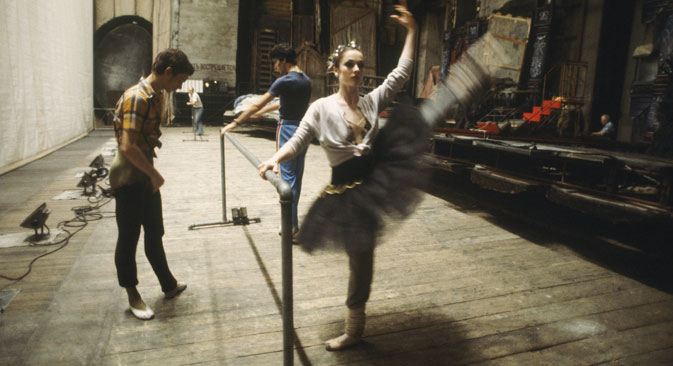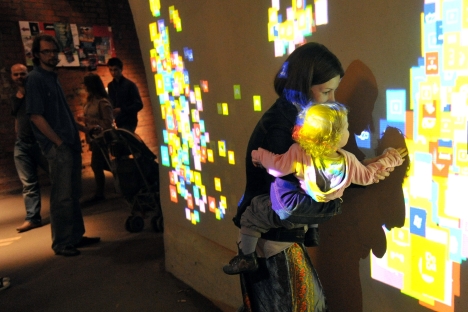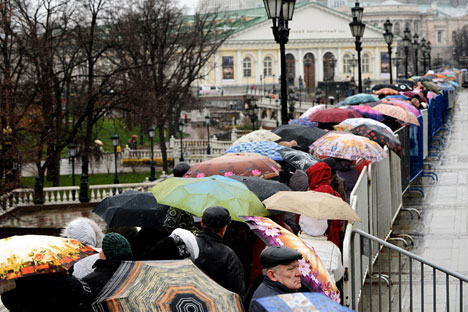
The Bolshoi Theater was awash in intrigues this year. Source: Corbis / FotoSA
Russia’s cultural establishments underwent several major developments in 2013 that saw an appreciation of the old and the introduction of the new.
Dozens of cultural institutions saw their management replaced. In the most high-profile reshuffle, Marina Loshak, the contemporary art curator at the Pushkin State Museum of Fine Arts, was appointed museum director. She replaced Irina Antonova, who had held the post for several decades.
Finally, Moscow's newest theatre, the Gogol Center (rebranded from the Moscow Drama Theater by scandalous director Kirill Serebrennikov), really spread its wings. Contemporary theater life has long stopped revolving around academic theaters like the Moscow Art Theater MKhAT and the Maly Theater. Once marginal, the Teatr.doc and Praktika Theater projects (which employ avant-garde theatrical techniques such as verbatim) no longer shock anyone: they are firmly established as an aspect of Moscow's cultural life.
The situation in St. Petersburg is more complicated. Local fundamentalists (Communists, Cossacks, and simply conservative and not overly educated residents) give a cold shoulder to any alternative art forms. This year's Side-By-Side international LGBT film festival nearly got banned.
This is understandable in the country where the word gay has been used as a pejorative term for too long. But the festival did take place, signaling that things are beginning to change.
Everything is happening at once, the old and the new. While in St. Petersburg, radicals insulted world-renowned director Lev Dodin, accusing him of worshipping the West, while in Moscow a park is being erected near the Kremlin to the blueprints of an avant-garde American project.
Muscovites queued for an exhibition devoted to the 400th anniversary of the Romanov dynasty, which showcased imperial relics and ceremonial portraits. The Long Night of Museums, with its fairly secular and non-pompous art, also gathered crowds.
For every classical festival there is now a modern one; for every mainstream flick, an art-house movie comes out; and for every pop concert in the Kremlin, there are dozens of sold-out club gigs.
This parallel life of the old and the new is the key trend of the times. You may call it confrontation or a normal development process.
Bolshoi
Source: ITAR-TASS
The Bolshoi Theater was awash in intrigues this year. World-renowned dancer Nikolay Tsiskaridze got fired for scheming against his enemies, who had also been scheming against him.
Sergey Filin, the artistic director of Bolshoi's ballet troupe who was also against Tsiskaridze, had a vial of acid flung in his face. Soloist Pavel Dmitrichenko was arrested for the attack, and was recently convicted. Prior to that, Filin had stripped prima ballerina Svetlana Zakharova of her Tatyana role in Bolshoi's “Onegin”. Zakharova complained to President Vladimir Putin.
As a result, Bolshoi director Anatoly Iskanov was sent packing. In the latest development, American dancer Joy Womack, who had quit the Bolshoi, accused Filin of demanding bribes for key roles in the theater's ballets.
The on-going scandals indicate a serious administrative crisis at Bolshoi. It is unlikely that the country's principal theater can continue operating normally in the current situation.
All is much quieter in St Petersburg's Mariinsky Theater, which inaugurated its long-awaited second stage in May.
Art nights

Source: Kommersant
The culture department of the Moscow mayor's office aims to integrate the Russian capital into the global cultural process. This involves revamping city parks to modern international standards, pedestrianizing the city center, and organizing popular night festivals throughout the years, such as the Long Night of Museums, BiblioNight, Music Night, and other events. These events are aimed at popularizing culture in the city.
Zaryadye Park

Source: Press photo
Immediately adjacent to the Kremlin is a wasteland known as Zaryadye, which used to be a marketplace in the 12th through 18th centuries. Following the Napoleonic invasion of 1812, in the course of which Moscow burnt down, the site was used for housing construction.
By the mid-19th century it turned into a Jewish ghetto, the only place in town where visiting Jewish merchants were allowed to stay. In Soviet times, Zaryadye hosted a multistoried hotel, which was demolished in 2006.
President Putin in 2012 suggested turning the site into a park. The tender was won by the U.S. architectural bureau Diller Scofidion + Renfro, whose previous projects include the magnificent High Line linear park in New York City. Even though Moscow's existing parks are getting rapidly modernized, there is as yet nothing in the capital that would compare with the Zaryadye project.
Faberge museum in St. Petersburg
Russian tycoon Viktor Vekselberg has opened a private museum of Carl Faberge works in St. Petersburg's Shuvalov Palace. The collection comprises around 4,000 exhibits.
Apart from Faberge's jewelry pieces, including the famous collection of Easter eggs, there are decorative works by other Russian jewelers, as well as paintings by Vladimir Makovsky, Ivan Aivazovsky, Karl Bryullov, Konstantin Korovin, and Pierre-Auguste Renoir.
Romanov dynasty's legacy exhibited
An exhibition marking the 400th anniversary of the Russian royal family has opened in Moscow Manege hall, the principal exhibition center of the country. An immediate success, the event gathered crowds of spectators, who had to queue for hours to get in.

People brave snow, rain and chill as they line up to visit the exhibition "My History. The Romanovs". Source: AFP/East News
Experts point out that in the current state of ideological transition, when Communism has already been taken out but the country's grip on Capitalism remains unsteady, many Russians identify with monarchy and religion.
New Russian Films
The three main Russian movies of the year catered to very different audiences.
The late acclaimed film director Alexey German spent more than a decade shooting the dystopia “Hard To Be A God.” He passed away in 2013, the movie still unfinished. German's son, also Alexey and also a film director, completed his father's work.
“Hard To Be A God” has not hit the screens in Russia yet, but premiered at the Rome film festival in November. It is graphic, mentally tolling and perceptually challenging. Critics are mostly cautious, but Umberto Eco was left exalted, saying that after German, Quentin Tarantino's movies are nothing more than Disney cartoons.
Fedor Bondarchuk's “Stalingrad” tells the story of the pivoting World War II battle. It is pointedly pro-Russian, patriotic, expensive, and successful. With a budget of about $30 million, “Stalingrad” broke even in the first 11 days of its release. Critics trashed the movie for numerous goofs and historical errors. Eco did not offer any comment at all. But “Stalingrad” is sure to make a good box office.
The hit of the season was “Gorko!,” a surprisingly shoestring-budgeted "B" comedy flick by no-name director Zhora Kryzhovnikov about guests getting plastered at a provincial wedding party. The movie's popularity can only be put down by its having hit a resonance with the collective unconscious.
Burning Man, Russian-style
Archstoyanie, this once low-profile landscape festival near the village of Nikola-Lenivets outside Moscow, has grown into a Mecca for art lovers. It all began when land artist Nikolay Polissky built a house in the village in the mid 1990s and gradually started involving locals in the erection of open-air art objects in the open. Today Archstoyanie is a popular commercial project not unlike Nevada's Burning Man.
Louis Vuitton suitcase in Red Square
The main architectural head turner of the year was the huge suitcase-shaped Louis Vuitton pavilion set up outside the GUM department store in Red Square. The project caused massive outrage: many Internet bloggers and politicians felt insulted by a "French coffer" taking up space in the country's main square.
After the Kremlin jumped on the rage bus, days after the pavilion opening, Louis Vuitton decided to dismantle the structure immediately. The "suitcase" was perhaps the shortest-lived building in the history of world architecture.
All rights reserved by Rossiyskaya Gazeta.
Subscribe
to our newsletter!
Get the week's best stories straight to your inbox